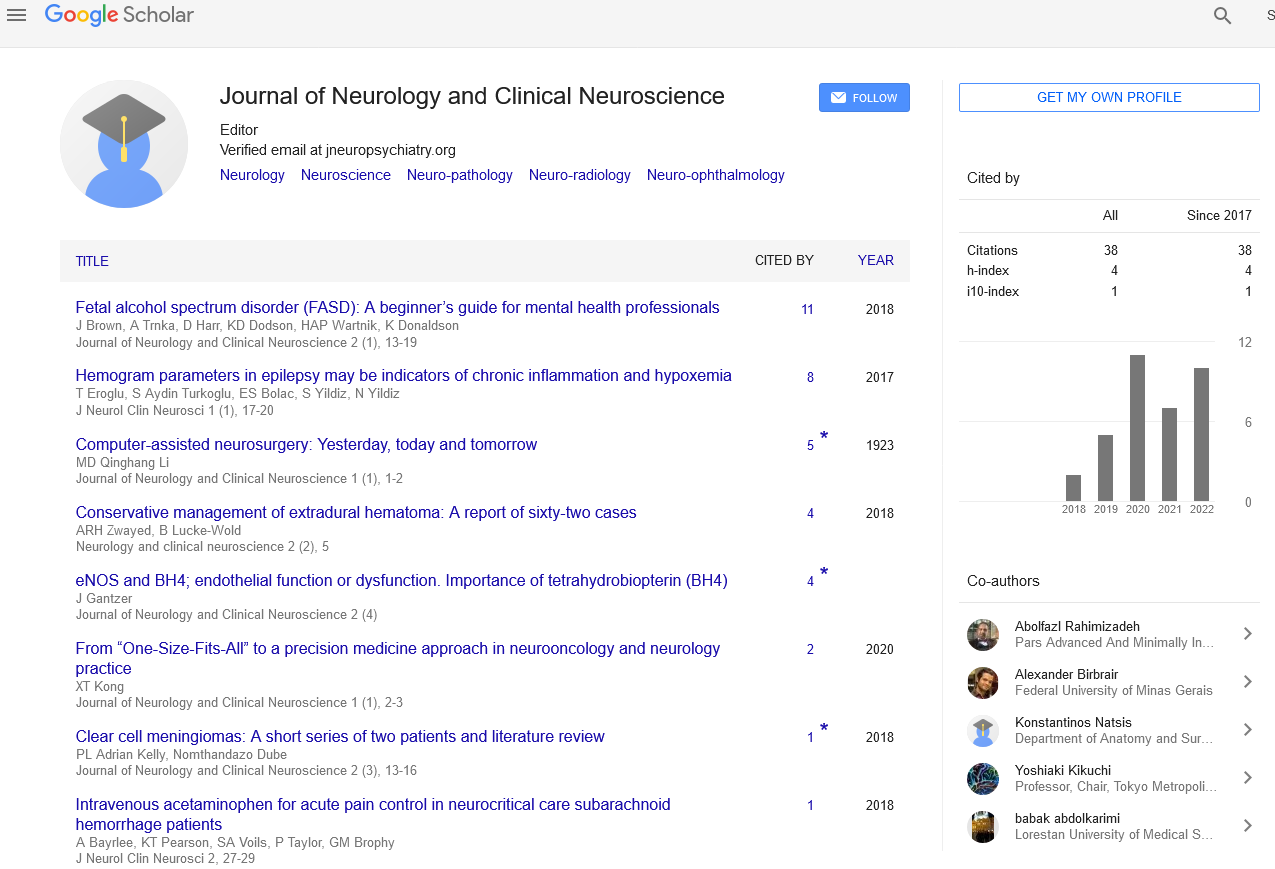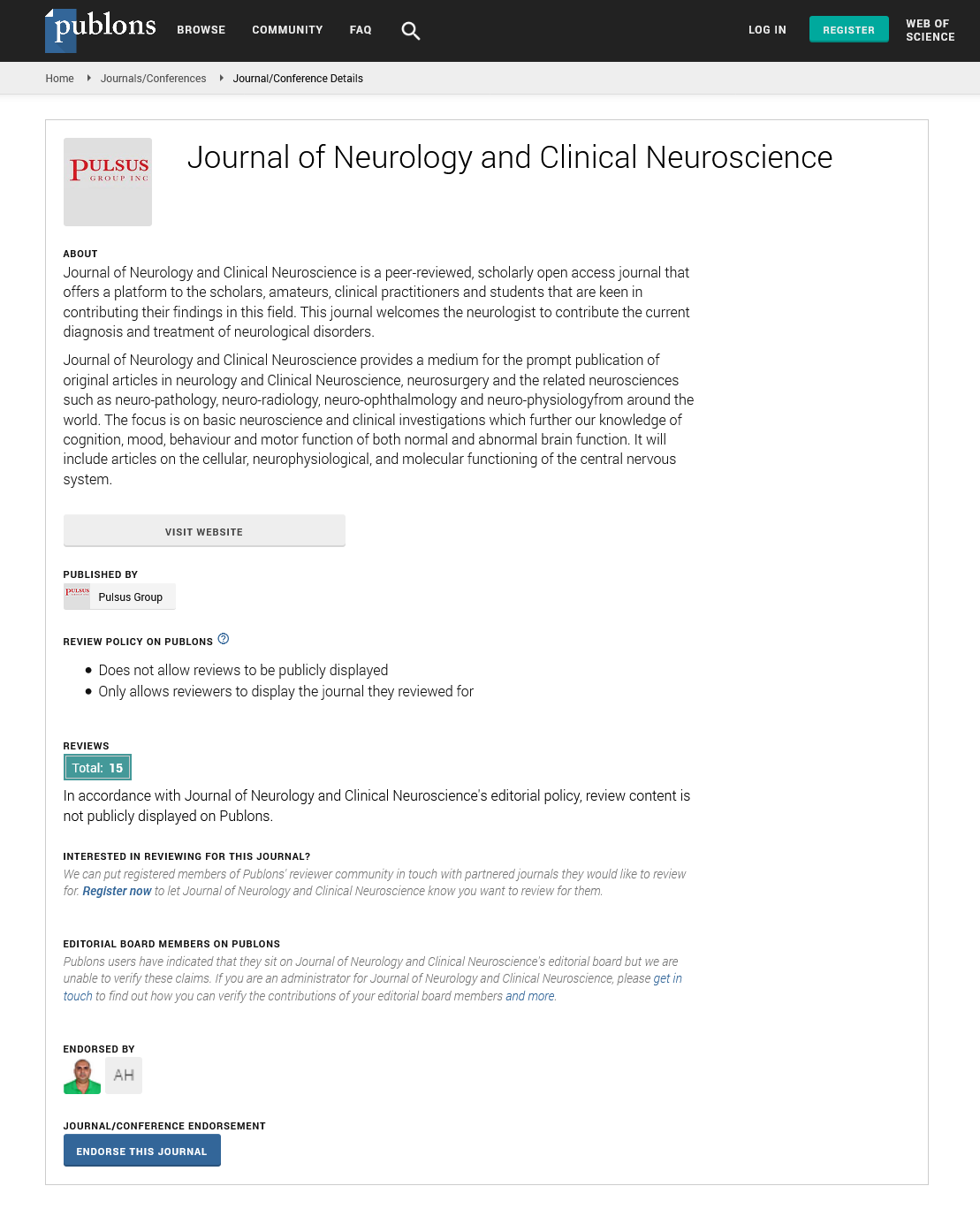Computer-assisted neurosurgery: Yesterday, today and tomorrow
Received: 27-Jul-2017 Accepted Date: Jul 27, 2017; Published: 23-Aug-2017
Citation: Li Q. Computer-assisted neurosurgery: Yesterday, today and tomorrow. Neurosurg J. 2017;1(1)1-2.
This open-access article is distributed under the terms of the Creative Commons Attribution Non-Commercial License (CC BY-NC) (http://creativecommons.org/licenses/by-nc/4.0/), which permits reuse, distribution and reproduction of the article, provided that the original work is properly cited and the reuse is restricted to noncommercial purposes. For commercial reuse, contact reprints@pulsus.com
Computer-assisted neurosurgery is a relatively new marginal discipline from the mid-1980s that leverages the rapid development and wide applications of computer science and technology in medicine. It combines traditional medicine with the rapid development of modern science and technology and significantly improves the diagnosis and treatment of clinical medicine. Here we review the history of computer assisted neurosurgery, the current status, and look forward to its future development.
Modern neurosurgery as an independent surgical specialty was born in the late eighteenth century on the European continent. In 1890 ZERNOW in Moscow described an apparatus called ENCEPHALOMETER, which was fixed on the patient’s skull and served to localize intracerebral anatomical structures based on superficial landmarks [1] Actual stereotactic calculation based on a coordinate system was invented by HORSLEY and CLARKE in 1906 [2] and 1908 [3]. They described a rigid frame attached to the skull which served as an immovable coordinate system in relation to which each point in the brain could be referred. The stereoscopic method was first applied to humans by KIRSCHNER in 1933 [4]. In the United States, HARVEY CUSHING (4/8/1869-10/7/1939), known as the father of neurosurgery, founded the specialty of neurosurgery at John Hopkins in 1912 after a European grand tour and a year in Kocher’s laboratory in Bern where he studied the effects of head injury. His clinical contributions were groundbreaking: the use of X-RAY in surgical practice, physiological saline for irrigation during the surgery and the understanding of pituitary’s function in early neurosurgery [5]. With the development of the stereotactic frame, SPIEGEL and WYCIS performed the first stereotactic thalamotomy on humans in 1947 using the commissura posterior or pineal body as an internal individual reference system [6,7]. Functional neurosurgery with similar frames and techniques were introduced by Talairach in 1949 in France [8], by Riechert in 1952 [9] in Germany, and by Leksell 1949 [10] in Sweden for the treatment of extrapyramidal movement disorders, intractable pain, epilepsy, and psychiatric disorders. After the advent of CT technology in the 1970s [11], stereotactic three-dimensional coordinates based calculations have been available for all intracranial space and can be used for intracranial biopsy, interstitial brachytherapy, endoscopy and localization of tumors for open craniotomy.
Today’s computer-assisted neurosurgery includes the following basic components:
1. Digital medical imaging data: Including CT (CTA, CTV, etc.) MRI (MRA, MR, fMRI and DTI, etc.) and PET and so on. Since the advent of CT in the 1970s, digital medical imaging data has been widely used in the diagnosis and treatment for neurosurgery, greatly improving the level of diagnosis and treatment. As digital medical imaging data can be required by stereotactic surgery to produce a corresponding spatial coordinate system of medical images, digital medical imaging data has thus become an important basis for computer-assisted neurosurgery, also known as IMAGE GUIDED NEUROSURGERY.
2. Localization and navigation: Perhaps the most important application of computer assisted neurosurgery is the image guidance to neurosurgery. Image guidance has been widely applied to brain surgery and also in the spinal surgery. To use digital imaging databases as maps for surgical navigation, it is necessary to register, or map, them onto the physical space of the patient’s anatomy. In a similar fashion, one image volume is registered to another image volume, so that both may be used simultaneously. After registration, a registered tool can be used as an “interactive localization device” which can used for intraoperative localization and navigation. Having accomplished registration, image guidance systems must successfully display image information to the surgeon in an intuitive, interactive, and useful way. The surgeon can clearly understand the location of the surgery and the surrounding environment of the anatomical structure. Intraoperative localization and navigation helps to maximize the removal of the tumor and reduce injury to surrounding normal tissue. Different medical imaging data have different applications, CT focuses on the bony structure, MRI focuses on soft tissue, MRA and CTA focuses on blood vessels, fMRI focuses on different functional areas of the brain, and DTI focuses on the nerve fibers and its direction. The data can be processed in the same coordinate system after registration and used for localization and navigation.
3. Application of medical robots: The application of modified robots in the medical field with high accuracy has been used in neurosurgery since the mid-1980s. In 1985, a PUMA560 automatic robot was used for the first time by KWOH for a fine brain biopsy [12]. In 1998, the automated operational microscope MKM (ZEISS), which was manufactured using manipulator technology, was used to start surgical application in our department. It can also be used for surgical navigation. BENABID and others developed the medical robot NEUROMATE [13] which has been used for neurosurgical procedures in our department since 2002 [14]. Its main advantage is to improve accuracy of the surgical navigation, reduce surgeon fatigue and optimize the surgical approach.
4. Practical application of intraoperative imaging: Currently we are used to the neuronavigation being based on preoperative digital medical imaging data (such as CT, MRI, PET, etc.). But preoperative medical images do not completely reflect the actual situation of the patient. When the patient moves, brain tissue deformation due to surgery can occur, it will significantly decrease the accuracy of the positioning. In order to ensure the accuracy of neuronavigation, intraoperative CT and MRI scanners have been created and are now used in surgical applications. It can continually update the CT and MRI images, so that the accuracy of neuronavigation positioning will not decline. At the same time, the changes in patients’ anatomical structures due to the surgical procedure can also be displayed onto the medical images for neuronavigation during the surgery. The surgeon can then use this information to adjust the procedure to optimize results.
The future of computer-assisted neurosurgery will be tightly linked to the development of computer science, such as big data, artificial intelligence, and advanced network technology. Several of the basic components described above will have new directions. Tomorrow’s digital medical images will become big data with artificial intelligence support, combined with a more efficient network technology so that neurosurgery could be more automated and standardized with fewer misdiagnoses. As neuronavigation and medical robots, advance with machine learning and integrated with surgical early warning systems, neurosurgery safety will undoubtedly improve. Intraoperative digital medical images will also become widely adopted, as the standard configuration for the operating room. With the continued advancement of science and technology, intraoperative medical images will become norm and traditional neurosurgery will enter a new era of computer assisted neurosurgery new.
REFERENCES
- Altuchow NW. Encephalometric investigation of brain in connection with sex, age and cranium size. Moscow (1891)
- Clarke R. On a method of investigating the deep ganglia and tracts of the central nervous system. Br Med J. 1906;2:1799–1800.
- Horsley V, Clarke RH. The structure and functions of the cerebellum examined by a new method. Brain. 1908;30(6):45–124.
- Kirschner M. Die Punktionstechnik und die Elektrokoagulation des Ganglion Gasseri. _ber gezielte Operationen. Arch Klin Chir. 1933;176(6):581–620.
- Cushing, Harvey. The basophil adenomas of the pituitary body and their clinical manifestations (pituitary basophilism. Bull Johns Hopkins Hosp. 1932;50:137-95. Reprinted in Cushing, Harvey (April 1969).
- Spiegel EA, Wycis HT, Marks M, et al. Stereotactic apparatus for operations on the human brain. Science. 1947;106(2754):349–50.
- Spiegel EA, Wycis HT. Stereoencephalotomy: thalamotomy and related procedures.1, Methods and stereotaxic atlas of the human brain. New York: Grune and Stratton. 1952.
- Talairach J, Hecaen H, David M, et al. Recherches sur la coagulation therapeutique des structures sous-corticales chez l’homme. Rev Neurol. 1949;81:4–24.
- Riechert T, Wolff M. Ein neues Zielger_t f_r die Koagulation des Ganglion Gasseri und andere intracerebrale Eingriffe. Acta Neurochir. 1952;2:405–7.
- Leksell L. A stereotactic apparatus for intracranialsurgery. Acta Chir Scand. 1949;99:229–33.
- Hounsfield GN. Computerized transaxial scanning (tomography). Part I: Description of a system. Br J Radiol. 1973;46(552):1016–22.
- Kwoh YS, Hou J, Jonckheere EA, et al. A robot with improved absolute positioning accuracy for CT guided stereotactic brain surgery. IEEE Trans Biomed Eng. 1988;35(2):153–60.
- Benabid A, Lavallee S, Hoffmann D, et al. Computer-driven robot for stereotactic neurosurgery. Computers in stereotactic surgery. Blackwell Scientific, Boston, 1992;330–42.
- Li Q.H., Zamorano L., Pandya A., et al. The application accuracy of the NeuroMate robot - A quantitative comparison with frameless and frame-based surgical localization systems. Computer Aided Surgery. 2002;7(2):90-8, 2002.





